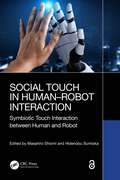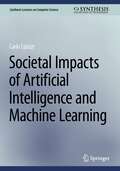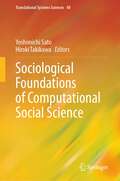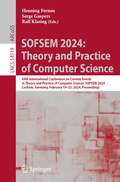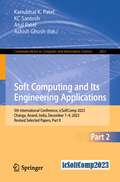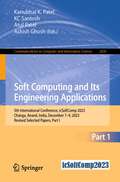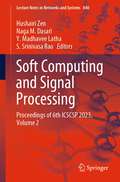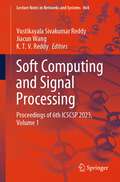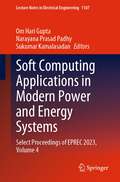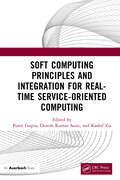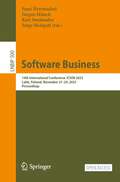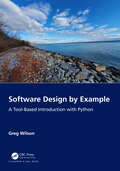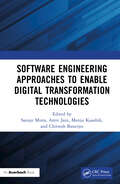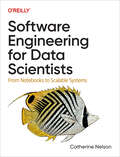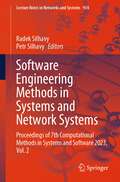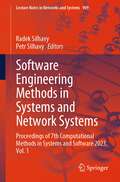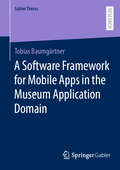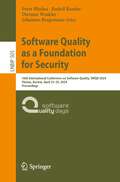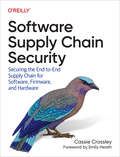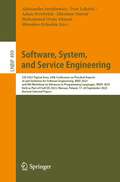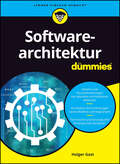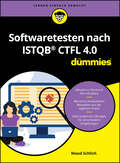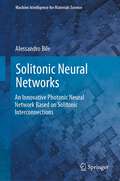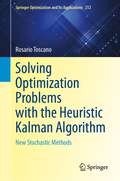- Table View
- List View
Social Touch in Human–Robot Interaction: Symbiotic touch interaction between human and robot
by Masahiro Shiomi Hidenobu SumiokaIn this book for researchers and students, editors Shiomi and Sumioka bring together contributions from researchers working on the CREST project at ATR Deep Interaction Laboratories, a world leader in social robotics, to comprehensively describe robot touch systems from hardware to applications.Appropriate touch from robots to humans is essential for social robots, but achieving this requires various solutions at every stage of the touch process. Through this book, readers will gain an understanding of the needs, essential systems and communication cues, behaviour designs, and real‑world issues for social touch applications. This book compiles and updates technical and empirical research that was previously scattered throughout the literature into a single volume. Through individually authored chapters addressing various elements of ATR’s CREST project, this book tackles key areas where understanding is needed to realize acceptable touch interaction, including pre‑touch interaction, interaction design for touching and being touched, behaviour changes caused by touch interaction, and applications of social touch interaction. It introduces a touch sensor and robots developed by the authors, including several touch‑related behaviours and design policies. This approach will enable readers to easily apply this knowledge to their own social robotics programs. This book is invaluable for anyone who wishes to understand and develop social robots that physically interact with people.It is most beneficial for researchers and upper undergraduate and graduate students in the fields of human–robot/agent/computer interaction and social touch interaction and those in the broader fields of engineering, computer science, and cognitive science.
Societal Impacts of Artificial Intelligence and Machine Learning (Synthesis Lectures on Computer Science)
by Carlo LipizziThis book goes beyond the current hype of expectations generated by the news on artificial intelligence and machine learning by analyzing realistic expectations for society, its limitations, and possible future scenarios for the use of this technology in our current society. Artificial Intelligence is one of the top topics today and is inflating expectations beyond what the technology can do in the foreseeable future. The future cannot be predicted, but the future of some elements of our society, such as technology, can be estimated. This book merges the modeling of human reasoning with the power of AI technology allowing readers to make more informed decisions about their personal or financial decisions or just being more educated on current technologies. This book presents a model that sketches potential future scenarios based on a discussion of the expectations today, the analysis of the current gap in the literature, and a view of possible futures in terms of technology and use cases. Specifically, this book merges literature on the technology aspects, the sociological impacts, and philosophical aspects.
Sociological Foundations of Computational Social Science (Translational Systems Sciences #40)
by Yoshimichi Sato Hiroki TakikawaThis book provides solid sociological foundations to computational social science (CSS). CSS is an emerging research field, and many books with those words in the title are on the market. However, CSS has not become mainstream in sociology, for which there are two reasons. First, CSS does not necessarily solve major research questions in sociology. Second, its sociological foundations are weak. These two reasons are interrelated—that is, CSS cannot solve major research questions because its sociological foundations are weak. Thus, even if it tries to solve those questions, its approaches seem to mainstream sociologists to miss the point. To resolve that shortcoming, this book fills the gap between CSS and sociology, shows that CSS can solve major research questions in sociology, and advances sociology by introducing to it theories and methodologies of CSS.
SOFSEM 2024: 49th International Conference on Current Trends in Theory and Practice of Computer Science, SOFSEM 2024, Cochem, Germany, February 19–23, 2024, Proceedings (Lecture Notes in Computer Science #14519)
by Henning Fernau Serge Gaspers Ralf KlasingThis book constitutes the proceedings of the 49th International Conference on Current Trends in Theory and Practice of Computer Science, SOFSEM 2024, held in Cochem, Germany, in February 2024. The 33 full papers presented in this book were carefully reviewed and selected from 81 submissions. The book also contains one invited talk in full paper length. They focus on original research and challenges in foundations of computer science including algorithms, AI-based methods, computational complexity, and formal models.
Soft Computing and Its Engineering Applications: 5th International Conference, icSoftComp 2023, Changa, Anand, India, December 7–9, 2023, Revised Selected Papers, Part II (Communications in Computer and Information Science #2031)
by Kanubhai K. Patel Kc Santosh Atul Patel Ashish GhoshThe two-volume proceedings constitutes the refereed proceedings of the 5th International Conference on Soft Computing and its Engineering Applications, icSoftComp 2023, held in Changa, Anand, India, in December 2023. The 42 full papers and 2 short papers included in this book were carefully reviewed and selected from 351 submissions. They are organized in topical sections as follows: Volume number 2020: Theory and Methods; Systems and ApplicationsVolume number 2031: Systems and Applications; Hybrid Techniques.
Soft Computing and Its Engineering Applications: 5th International Conference, icSoftComp 2023, Changa, Anand, India, December 7–9, 2023, Revised Selected Papers, Part I (Communications in Computer and Information Science #2030)
by Kanubhai K. Patel Kc Santosh Atul Patel Ashish GhoshThe two-volume proceedings constitutes the refereed proceedings of the 5th International Conference on Soft Computing and its Engineering Applications, icSoftComp 2023, held in Changa, Anand, India, in December 2023. The 42 full papers and 2 short papers included in this book were carefully reviewed and selected from 351 submissions. They are organized in topical sections as follows: Volume number 2020: Theory and Methods; Systems and ApplicationsVolume number 2031: Systems and Applications; Hybrid Techniques.
Soft Computing and Signal Processing: Proceedings of 6th ICSCSP 2023, Volume 2 (Lecture Notes in Networks and Systems #840)
by Hushairi Zen Naga M. Dasari Y. Madhavee Latha S. Srinivasa RaoThis book presents selected research papers on current developments in the fields of soft computing and signal processing from the Sixth International Conference on Soft Computing and Signal Processing (ICSCSP 2023). The book covers topics such as soft sets, rough sets, fuzzy logic, neural networks, genetic algorithms and machine learning and discusses various aspects of these topics, e.g., technological considerations, product implementation and application issues.
Soft Computing and Signal Processing: Proceedings of 6th ICSCSP 2023, Volume 1 (Lecture Notes in Networks and Systems #864)
by Vustikayala Sivakumar Reddy Jiacun Wang K. T. V. ReddyThis book presents selected research papers on current developments in the fields of soft computing and signal processing from the Sixth International Conference on Soft Computing and Signal Processing (ICSCSP 2023). The book covers topics such as soft sets, rough sets, fuzzy logic, neural networks, genetic algorithms and machine learning and discusses various aspects of these topics, e.g., technological considerations, product implementation and application issues.
Soft Computing Applications in Modern Power and Energy Systems: Select Proceedings of EPREC 2023, Volume 4 (Lecture Notes in Electrical Engineering #1107)
by Om Hari Gupta Narayana Prasad Padhy Sukumar KamalasadanThis book includes select proceedings of EPREC 2023. It provides rigorous discussions, case studies, and recent developments in the areas of soft computing and its applications in power systems enabled with power electronics-based equipment, energy systems, and the energy community. The other topics to be covered are optimal planning, analysis, operation, and control related to modern power and energy systems, and applications of various soft computing methodologies. The readers find this book useful for enhancing their knowledge and skills in the domain areas.
Soft Computing Principles and Integration for Real-Time Service-Oriented Computing
by Punit Gupta Dinesh Kumar Saini Kashif ZiaIn recent years, soft computing techniques have emerged as a successful tool to understand and analyze the collective behavior of service- oriented computing software. Algorithms and mechanisms of self- organization of complex natural systems have been used to solve problems, particularly in complex systems, which are adaptive, ever- evolving, and distributed in nature across the globe. What fits more perfectly into this scenario other than the rapidly developing era of Fog, IoT, and Edge computing environment? Service- oriented computing can be enhanced with soft computing techniques embedded inside the Cloud, Fog, and IoT systems.Soft Computing Principles and Integration for Real-Time Service-Oriented Computing explores soft computing techniques that have wide application in interdisciplinary areas. These soft computing techniques provide an optimal solution to the optimization problem using single or multiple objectives.The book focuses on basic design principles and analysis of soft computing techniques. It discusses how soft computing techniques can be used to improve quality-of-service in serviceoriented architectures. The book also covers applications and integration of soft computing techniques with a service- oriented computing paradigm. Highlights of the book include: A general introduction to soft computing An extensive literature study of soft computing techniques and emerging trends Soft computing techniques based on the principles of artificial intelligence, fuzzy logic, and neural networks The implementation of SOC with a focus on service composition and orchestration, quality of service (QoS) considerations, security and privacy concerns, governance challenges, and the integration of legacy systems The applications of soft computing in adaptive service composition, intelligent service recommendation, fault detection and diagnosis, SLA management, and security Such principles underlying SOC as loose coupling, reusability, interoperability, and abstraction An IoT based framework for real time data collection and analysis using soft computing
Software Business: 14th International Conference, ICSOB 2023, Lahti, Finland, November 27–29, 2023, Proceedings (Lecture Notes in Business Information Processing #500)
by Sami Hyrynsalmi Jürgen Münch Kari Smolander Jorge MelegatiThis open access book constitutes the refereed proceedings of the 23rd International Conference on Software Business, ICSOB 2023, which was held in Lahti, Finland, during November 27–29, 2023. The special theme of ICSOB 2023 was Digital Agility: Mastering Change in Software Business and Digital Services.The 27 full papers and 8 short papers presented in this book were carefully reviewed and selected from 79 submissions. They were organized in topical sections as follows: Requirements; software procurement; platforms, ecosystems and data; artificial intelligence; software startups; software product management; software and business co-development; and emerging digital world.
Software Design by Example: A Tool-Based Introduction with Python
by Greg WilsonThe best way to learn design in any field is to study examples, and some of the best examples of software design come from the tools programmers use in their own work. Software Design by Example: A Tool-Based Introduction with Python therefore builds small versions of the things programmers use in order to demystify them and give some insights into how experienced programmers think. From a file backup system and a testing framework to a regular expression matcher, a browser layout engine, and a very small compiler, we explore common design patterns, show how making code easier to test also makes it easier to reuse, and help readers understand how debuggers, profilers, package managers, and version control systems work so that they can use them more effectively.This material can be used for self-paced study, in an undergraduate course on software design, or as the core of an intensive weeklong workshop for working programmers. Each chapter has a set of exercises ranging in size and difficulty from half a dozen lines to a full day’s work. Readers should be familiar with the basics of modern Python, but the more advanced features of the language are explained and illustrated as they are introduced.All the written material in this project can be freely reused under the terms of the Creative Commons - Attribution license, while all of the software is made available under the terms of the Hippocratic License. All proceeds from sale of this book will go to support the Red Door Family Shelter in Toronto.Features:• Teaches software design by showing programmers how to build the tools they useevery day• Each chapter includes exercises to help readers check and deepen their understanding• All the example code can be downloaded, re-used, and modified under an open license
Software Engineering Approaches to Enable Digital Transformation Technologies
by Sanjay Misra Amit Jain Manju Kaushik Chitresh BanerjeeSoftware Engineering Approaches to Enable Digital Transformation Technologies features contributions reflecting ideas and research in enabling digital transformation technologies through software engineering. To date, multiple, different approaches have been adopted to develop software solutions for a variety of different problems. Of all the available approaches, the main approaches are level-oriented, data flow-oriented, data structure-oriented, and object-oriented design approaches. The other focus of the book is digital transformation, which can be defined as the adoption of digital technology to improve efficiency, value, and innovation Digitalization is more than just putting additional technological systems and services in place. Rather than improving conventional methods, a true digital transformation initiative includes radically rethinking company structures and procedures. There are four types of digital transformation: business process, business model, domain, and cultural and organizational. Companies are being challenged to develop new business models that consider and harness digitalization. From the standpoint of software engineering, digital transformation alters how software is built. Current trends include the development of mobile applications, cloud applications, and Internet of Things (IoT) applications. Emerging trends are the development of digital twins, robotics, artificial intelligence, machine learning, augmented reality, and additive manufacturing. This book examines the challenges that arise due to digitization in society and presents plausible solutions that could be applied to counter these challenges and convert them into opportunities. These solutions may further be improvised and worked out for the software companies from the technological perspective, organizational perspective, and management perspective.
Software Engineering for Data Scientists
by Catherine NelsonData science happens in code. The ability to write reproducible, robust, scaleable code is key to a data science project's success—and is absolutely essential for those working with production code. This practical book bridges the gap between data science and software engineering,and clearly explains how to apply the best practices from software engineering to data science.Examples are provided in Python, drawn from popular packages such as NumPy and pandas. If you want to write better data science code, this guide covers the essential topics that are often missing from introductory data science or coding classes, including how to:Understand data structures and object-oriented programmingClearly and skillfully document your codePackage and share your codeIntegrate data science code with a larger code baseLearn how to write APIsCreate secure codeApply best practices to common tasks such as testing, error handling, and loggingWork more effectively with software engineersWrite more efficient, maintainable, and robust code in PythonPut your data science projects into productionAnd more
Software Engineering Methods in Systems and Network Systems: Proceedings of 7th Computational Methods in Systems and Software 2023, Vol. 2 (Lecture Notes in Networks and Systems #934)
by Radek Silhavy Petr SilhavyThis book presents cutting-edge research and methodologies in software engineering, specifically focusing on systems and network systems. It showcases novel development approaches and network system optimizations, highlighting the field's dynamic evolution. The book is designed for experts, scholars, and professionals, offering insights and tools crucial for advancing the software engineering landscape. Its diverse content makes it an invaluable resource for seasoned professionals and those new to the field, inspiring and enriching readers' understanding of software engineering's future directions.
Software Engineering Methods in Systems and Network Systems: Proceedings of 7th Computational Methods in Systems and Software 2023, Vol. 1 (Lecture Notes in Networks and Systems #909)
by Radek Silhavy Petr SilhavyThis book presents cutting-edge research and methodologies in software engineering, specifically focusing on systems and network systems. It showcases novel development approaches and network system optimizations, highlighting the field's dynamic evolution. The book is designed for experts, scholars, and professionals, offering insights and tools crucial for advancing the software engineering landscape. Its diverse content makes it an invaluable resource for seasoned professionals and those new to the field, inspiring and enriching readers' understanding of software engineering's future directions.
A Software Framework for Mobile Apps in the Museum Application Domain (Gabler Theses)
by Tobias BaumgärtnerThis book is concerned with “How to provide guidance for small cultural heritage institutions to govern digital transformation, and how to align the possibilities with the available capabilities by creating a Software Framework for Mobile Apps in the Museum Application Domain?”. The role of the museum has shifted from a keeper of artifacts to a provider of information. In this context mobile applications are intended to generate added value for the museum visitor. However, the tension between the application’s creator, its content, and the consumer operating the app needs to be examined holistically. As it is not trivial to create an integrated user experience, the unique usability-centered perspective on the requirements engineering pursued throughout, allows for the suggested data-driven solution to address the specific domain issues and serve the intended audience. Based on the insights gained during this examination and under the utilization of design science research, human-centered design, and domain-driven design “A Software Framework for Mobile Apps in the Museum Application Domain” is created and implemented using web technologies.
Software Quality as a Foundation for Security: 16th International Conference on Software Quality, SWQD 2024, Vienna, Austria, April 23–25, 2024, Proceedings (Lecture Notes in Business Information Processing #505)
by Peter Bludau Rudolf Ramler Dietmar Winkler Johannes BergsmannThis book constitutes the refereed proceedings of the 16th Software Quality Days Conference, SWQD 2024, held in Vienna, Austria, during April 23-25, 2024. The Software Quality Days (SWQD) conference started in 2009 and has grown to the biggest conference on software quality in Europe. The program of the SWQD conference is designed to encompass a stimulating mixture of practical presentations and new research topics in scientific presentations. The guiding conference topic of the SWQD 2024 is “Software Quality as a Foundation for Security”. The 7 full papers and 2 short papers presented in this volume were carefully reviewed and selected from 16 submissions. The papers were organized in topical sections as follows: Requirements engineering; software quality; continuous integration and deployment; communication and collaboration; artificial intelligence; and security and compliance.
Software Supply Chain Security
by Cassie CrossleyTrillions of lines of code help us in our lives, companies, and organizations. But just a single software cybersecurity vulnerability can stop entire companies from doing business and cause billions of dollars in revenue loss and business recovery. Securing the creation and deployment of software, also known as software supply chain security, goes well beyond the software development process.This practical book gives you a comprehensive look at security risks and identifies the practical controls you need to incorporate into your end-to-end software supply chain. Author Cassie Crossley demonstrates how and why everyone involved in the supply chain needs to participate if your organization is to improve the security posture of its software, firmware, and hardware.With this book, you'll learn how to:Pinpoint the cybersecurity risks in each part of your organization's software supply chainIdentify the roles that participate in the supply chain—including IT, development, operations, manufacturing, and procurementDesign initiatives and controls for each part of the supply chain using existing frameworks and referencesImplement secure development lifecycle, source code security, software build management, and software transparency practicesEvaluate third-party risk in your supply chain
Software, System, and Service Engineering: S3E 2023 Topical Area, 24th Conference on Practical Aspects of and Solutions for Software Engineering, KKIO 2023, and 8th Workshop on Advances in Programming Languages, WAPL 2023, Held as Part of FedCSIS 2023, Warsaw, Poland, 17–20 September 2023, Revised Selected Papers (Lecture Notes in Business Information Processing #499)
by Aleksander Jarzębowicz Ivan Luković Adam Przybyłek Mirosław Staroń Muhammad Ovais Ahmad Mirosław OchodekThis book constitutes the refereed proceedings of the S3E 2023 Topical Area, 24th Conference on Practical Aspects of and Solutions for Software Engineering, KKIO 2023, and 8th Workshop on Advances in Programming Languages, WAPL 2023, as Part of FedCSIS 2023, held in Warsaw, Poland, during September 17–20, 2023. The 6 revised papers presented in this book were carefully reviewed and selected from a total of 55 submissions. They focus on new ideas and developments in practical aspects and solutions for software engineering.
Softwarearchitektur für Dummies (Für Dummies)
by Holger GastTragfähige Literatur für Ihre Softwarearchitekturen Besuchen Sie eine Veranstaltung zu Softwarearchitektur oder stehen Sie in einem Projekt vor Architekturentscheidungen und wollen daher die aktuellen Architekturansätze verstehen? Dann hilft Ihnen dieses Buch. Holger Gast erläutert zunächst die grundlegenden Elemente von Architekturen und führt die technischen Hintergründe aus. Er erklärt Ihnen danach die klassischen Stile und Patterns und geht schließlich auf Cloud-Architekturen ein. Durchgängig legt er den Fokus auf konkrete Softwarestrukturen statt auf Theorie und ermöglicht Ihnen so einen verständlichen und zügigen Einstieg in das Thema. Sie erfahren Wie Sie Entscheidungen zum Aufbau einer Anwendung treffen Wann bestimmte Architekturen oder Frameworks für Ihr Projekt geeignet sind Welche Herausforderungen Sie bei der Erstellung oder Weiterentwicklung einer Anwendung lösen müssen
Softwaretesten nach ISTQB CTFL 4.0 für Dummies (Für Dummies)
by Maud SchlichNeue Hauptversion 4.0: Neuer Lehrplan, geänderter Prüfungsumfang! Soll in Ihrem Unternehmen neue Software eingeführt werden und Sie müssen sie testen? Oder wollen Sie als Entwickler über den Tellerrand schauen und sich auch mit dem Softwaretesten beschäftigen? Leicht verständlich erläutert Ihnen Maud Schlich alle vom ISTQB® Certified Tester Foundation Level geforderten Lerninhalte sowohl für Programmierer als auch mit Blick auf Fachanwender, die die Software später einsetzen. Zahlreiche praxisorientierte Beispiele und übungen sorgen für eine optimale Prüfungsvorbereitung. Darüber hinaus erfahren Sie für alle Testaktivitäten, wie sie jeweils im klassischen oder im agilen Kontext geplant und durchgeführt werden. Sie erfahren Aus welchen Aktivitäten der Testprozess besteht Wie Sie unterschiedliche Testverfahren nutzen Wie Entwickler und Tester optimal zusammenarbeiten Wie Sie prüfen, ob Sie noch im Plan sind
Solitonic Neural Networks: An Innovative Photonic Neural Network Based on Solitonic Interconnections (Machine Intelligence for Materials Science)
by Alessandro BileThis book delves into optics and photonic materials, describing the development of an intelligent all-optical system capable of replicating the functional building blocks of the biological brain. Starting with an analysis of biological neuronal dynamics and traversing the state of the art of neuromorphic systems developed to date, the book arrives at a description of neural networks realized through spatial soliton technology.After a brief introduction to the biology of neural networks (Chapter 1), the book delves into the description of the neuromorphic problem emphasizing the peculiarities of optical hardware developed to date. (Chapter 2). Chapter 3 is dedicated to the description of psychomemories , which represent the modeling of human learning according to the theories of modern neuro-psychology. This chapter provides the prerequisites for understanding how solitonic neural networks (SNNs) are able to learn and how they approach biological models. Chapter 4 focuses on the experimentation of solitonic optic neurons in thin layers of lithium niobate. Optical techniques for supervised and unsupervised learning are discussed. The entire chapter is accompanied by theoretical, simulative and experimental results. This chapter explains how an X-junction neuron is able to establish synapses, modify them, or erase them. The erasure of solitonic structures represents an important innovation in the field of nonlinear optics. Finally, Chapter 5 reports on the implementation of a network of neurons capable of processing information and storing it exactly as a human episodic memory does. The chapter ends with a number of insights into the lines of research that are currently being pursued on the basis of the results obtained.The book is meant for graduate students and researchers in the fields of optics, photonic applications, and biology. However, the main beneficiaries of this book are senior researchers in the field of nonlinear optics and artificial intelligence. To fully understand the results, it is important to have a basic knowledge of optical physics and neuron biology.
Solving Optimization Problems with the Heuristic Kalman Algorithm: New Stochastic Methods (Springer Optimization and Its Applications #212)
by Rosario ToscanoThis text focuses on simple and easy-to-use design strategies for solving complex engineering problems that arise in several fields of engineering design, namely non-convex optimization problems. The main optimization tool used in this book to tackle the problem of nonconvexity is the Heuristic Kalman Algorithm (HKA). The main characteristic of HKA is the use of a stochastic search mechanism to solve a given optimization problem. From a computational point of view, the use of a stochastic search procedure appears essential for dealing with non-convex problems.The topics discussed in this monograph include basic definitions and concepts from the classical optimization theory, the notion of the acceptable solution, machine learning, the concept of preventive maintenance, and more. The Heuristic Kalman Algorithm discussed in this book applies to many fields such as robust structured control, electrical engineering, mechanical engineering, machine learning, reliability, and preference models. This large coverage of practical optimization problems makes this text very useful to those working on and researching systems design. The intended audience includes industrial engineers, postgraduates, and final-year undergraduates in various fields of systems design.
Space and Play in Japanese Videogame Arcades (Routledge Contemporary Japan Series)
by Jérémie Pelletier-GagnonThis book presents a scholarly investigation of the development and culture of Japanese videogame arcades, both from a historical and contemporary point of view.Providing an overview of the historical evolution of public amusement spaces from the early rooftop amusement spaces from the early nineteenth century to the modern multi‑floor and interconnected arcade complexes that characterize the urban fabric of contemporary Japan, the book argues that arcade videogames and their associated practices must be examined in the context in which they are played, situated in the interrelation between the game software, the cabinets as material conditions of play, and the space of the venue that frames the experience. Including three case studies of distinct and significant game centres located in Tokyo and Kyoto, the book addresses of play in public, including the notion of performance and observation as play practices, spatial appropriation, as well as the compartmentalization of the play experience.In treating videogames as sets of circumstances, the book identifies the opportunities for ludic practices that videogame arcades provide in Japan. As such, it will appeal to students and scholars of Game Studies and Digital Media Studies, as well as those of Japanese Culture and Society.
